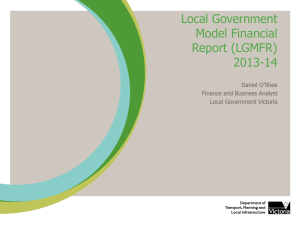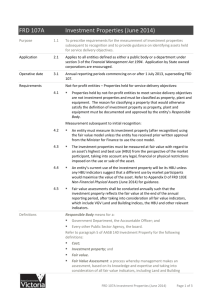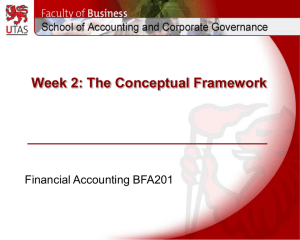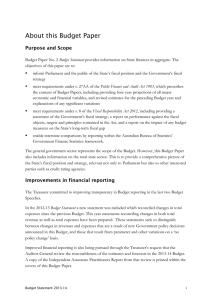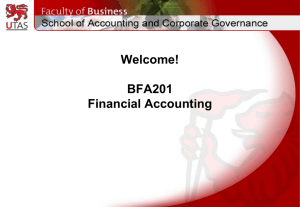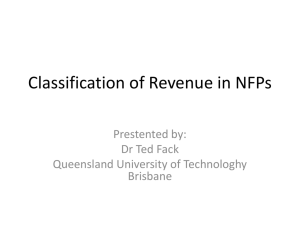PRIMA Forms - Attachment A
advertisement
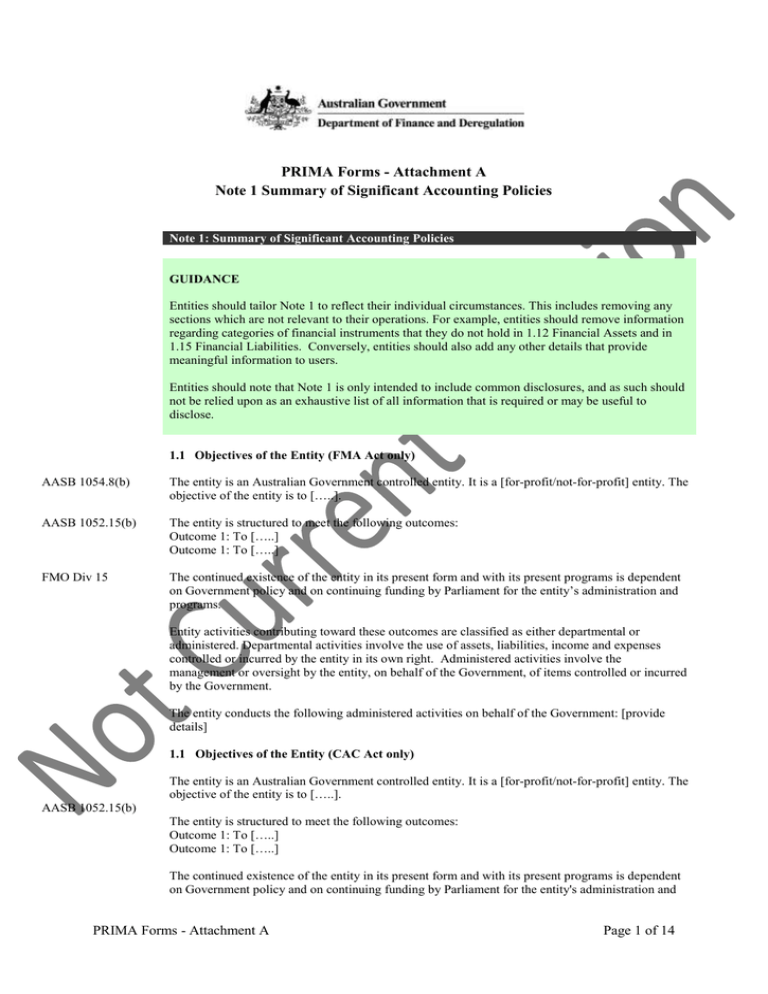
PRIMA Forms - Attachment A Note 1 Summary of Significant Accounting Policies Note 1: Summary of Significant Accounting Policies GUIDANCE Entities should tailor Note 1 to reflect their individual circumstances. This includes removing any sections which are not relevant to their operations. For example, entities should remove information regarding categories of financial instruments that they do not hold in 1.12 Financial Assets and in 1.15 Financial Liabilities. Conversely, entities should also add any other details that provide meaningful information to users. Entities should note that Note 1 is only intended to include common disclosures, and as such should not be relied upon as an exhaustive list of all information that is required or may be useful to disclose. 1.1 Objectives of the Entity (FMA Act only) AASB 1054.8(b) The entity is an Australian Government controlled entity. It is a [for-profit/not-for-profit] entity. The objective of the entity is to […..]. AASB 1052.15(b) The entity is structured to meet the following outcomes: Outcome 1: To […..] Outcome 1: To […..] FMO Div 15 The continued existence of the entity in its present form and with its present programs is dependent on Government policy and on continuing funding by Parliament for the entity’s administration and programs. Entity activities contributing toward these outcomes are classified as either departmental or administered. Departmental activities involve the use of assets, liabilities, income and expenses controlled or incurred by the entity in its own right. Administered activities involve the management or oversight by the entity, on behalf of the Government, of items controlled or incurred by the Government. The entity conducts the following administered activities on behalf of the Government: [provide details] 1.1 Objectives of the Entity (CAC Act only) The entity is an Australian Government controlled entity. It is a [for-profit/not-for-profit] entity. The objective of the entity is to […..]. AASB 1052.15(b) The entity is structured to meet the following outcomes: Outcome 1: To […..] Outcome 1: To […..] The continued existence of the entity in its present form and with its present programs is dependent on Government policy and on continuing funding by Parliament for the entity's administration and PRIMA Forms - Attachment A Page 1 of 14 programs. 1.2 Basis of Preparation of the Financial Statements The financial statements are general purpose financial statements and are required by [select a relevant act]: a) section 49 of the Financial Management and Accountability Act 1997; b) clause 1(b) of Schedule 1 to the Commonwealth Authorities and Companies Act 1997; c) [other legislation – list as applicable]. FMO Div 8 AASB 1054.8(a) AASB 101.27 AASB 101.117(a) AASB 101.51(d) FMO Div 13 The financial statements have been prepared in accordance with: a) Finance Minister’s Orders (FMOs) for reporting periods ending on or after 1 July 2011; and b) Australian Accounting Standards and Interpretations issued by the Australian Accounting Standards Board (AASB) that apply for the reporting period. The financial statements have been prepared on an accrual basis and in accordance with the historical cost convention, except for certain assets and liabilities at fair value. Except where stated, no allowance is made for the effect of changing prices on the results or the financial position. The financial statements are presented in Australian dollars and values are rounded to the nearest [thousand/million] dollars unless otherwise specified. Unless an alternative treatment is specifically required by an accounting standard or the FMOs, assets and liabilities are recognised in the balance sheet when and only when it is probable that future economic benefits will flow to the entity or a future sacrifice of economic benefits will be required and the amounts of the assets or liabilities can be reliably measured. However, assets and liabilities arising under executor contracts are not recognised unless required by an accounting standard. Liabilities and assets that are unrecognised are reported in the schedule of commitments or the schedule of contingencies. Unless alternative treatment is specifically required by an accounting standard, income and expenses are recognised in the Statement of Comprehensive Income when and only when the flow, consumption or loss of economic benefits has occurred and can be reliably measured. 1.3 Significant Accounting Judgements and Estimates AASB 101.122 In the process of applying the accounting policies listed in this note, the entity has made the following judgements that have the most significant impact on the amounts recorded in the financial statements: [insert details] AASB 101.125 The following accounting assumptions and estimates have been identified that have a significant risk of causing a material adjustment to the carrying amounts of assets and liabilities within the next reporting period: [provide details] 1.4 New Australian Accounting Standards AASB 108.28 Adoption of New Australian Accounting Standard Requirements No accounting standard has been adopted earlier than the application date as stated in the standard. The following [new standards/revised standards/interpretations/amending standards] were issued prior to the sign-off date, were applicable to the current reporting period and had a financial impact on the entity: (Separate guidance will be provided by Finance after 30 June on new accounting standards applicable to current and future reporting periods). PRIMA Forms - Attachment A Page 2 of 14 Other [new standards/revised standards/interpretations/amending standards] that were issued prior to the sign-off date and are applicable to the current reporting period did not have a financial impact, and are not expected to have a future financial impact on the entity. AASB 108.30-31 Future Australian Accounting Standard Requirements The following [new standards/revised standards/interpretations/amending standards] were issued by the Australian Accounting Standards Board prior to the sign-off date, which are expected to have a financial impact on the entity for future reporting periods: (Separate guidance will be provided by Finance after 30 June on new accounting standards applicable to current and future reporting periods). Other [new standards/revised standards/interpretations/amending standards] that were issued prior to the sign-off date and are applicable to the future reporting period are not expected to have a future financial impact on the entity. 1.5 Revenue AASB 118.14 Revenue from the sale of goods is recognised when: a) the risks and rewards of ownership have been transferred to the buyer; b) the entity retains no managerial involvement or effective control over the goods; c) the revenue and transaction costs incurred can be reliably measured; and d) it is probable that the economic benefits associated with the transaction will flow to the entity. AASB 118.20 Revenue from rendering of services is recognised by reference to the stage of completion of contracts at the reporting date. The revenue is recognised when: a) the amount of revenue, stage of completion and transaction costs incurred can be reliably measured; and b) the probable economic benefits associated with the transaction will flow to the entity. AASB 118.24 The stage of completion of contracts at the reporting date is determined by reference to [select from the following]: a) surveys of work performed; b) services performed to date as a percentage of total services to be performed; or c) the proportion that costs incurred to date bear to the estimated total costs of the transaction. Receivables for goods and services, which have 30 day terms, are recognised at the nominal amounts due less any impairment allowance account. Collectability of debts is reviewed at end of the reporting period. Allowances are made when collectability of the debt is no longer probable. Interest revenue is recognised using the effective interest method as set out in AASB 139 Financial Instruments: Recognition and Measurement. AASB 118.30(a) Resources Received Free of Charge Resources received free of charge are recognised as revenue when, and only when, a fair value can be reliably determined and the services would have been purchased if they had not been donated. Use of those resources is recognised as an expense. Resources received free of charge are recorded as either revenue or gains depending on their nature. Contributions of assets at no cost of acquisition or for nominal consideration are recognised as gains at their fair value when the asset qualifies for recognition, unless received from another Government agency or authority as a consequence of a restructuring of administrative arrangements (refer to Note 1.7). AASB 118.35(a) FMO Div 101 Revenue from Government Amounts appropriated for departmental appropriations for the year (adjusted for any formal additions and reductions) are recognised as Revenue from Government when the entity gains control of the appropriation, except for certain amounts that relate to activities that are reciprocal in nature, PRIMA Forms - Attachment A Page 3 of 14 in which case revenue is recognised only when it has been earned. Appropriations receivable are recognised at their nominal amounts. Funding received or receivable from agencies (appropriated to the agency as a CAC Act body payment item for payment to this entity) is recognised as Revenue from Government by the CAC Act Body unless the funding is in the nature of an equity injection or a loan. Parental Leave Payments Scheme(For-profit entities only) Amounts received under the Parental Leave Payments Scheme by the entity not yet paid to employees were presented gross as cash and a liability (payable). The total amount received under this scheme was [$....] (2012: $....). 1.6 Gains Resources Received Free of Charge Resources received free of charge are recognised as gains when, and only when, a fair value can be reliably determined and the services would have been purchased if they had not been donated. Use of those resources is recognised as an expense. Resources received free of charge are recorded as either revenue or gains depending on their nature. Contributions of assets at no cost of acquisition or for nominal consideration are recognised as gains at their fair value when the asset qualifies for recognition, unless received from another Government entity as a consequence of a restructuring of administrative arrangements (refer to Note 1.7). Sale of Assets Gains from disposal of assets are recognised when control of the asset has passed to the buyer. 1.7 Transactions with the Government as Owner Equity Injections Amounts appropriated which are designated as ‘equity injections’ for a year (less any formal reductions) and Departmental Capital Budgets (DCBs) are recognised directly in contributed equity in that year. Int 1038 Restructuring of Administrative Arrangements Net assets received from or relinquished to another Government entity under a restructuring of administrative arrangements are adjusted at their book value directly against contributed equity. FMO Div 92 Other Distributions to Owners The FMOs require that distributions to owners be debited to contributed equity unless it is in the nature of a dividend. In 2011-12, by agreement with the Department of Finance and Deregulation, the entity [……]. FMO Div 101 1.8 Employee Benefits AASB 119.10 Liabilities for ‘short-term employee benefits’ (as defined in AASB 119 Employee Benefits) and termination benefits due within twelve months of the end of reporting period are measured at their nominal amounts. AASB 119.14 The nominal amount is calculated with regard to the rates expected to be paid on settlement of the liability. AASB 119.128 Other long-term employee benefits are measured as net total of the present value of the defined benefit obligation at the end of the reporting period minus the fair value at the end of the reporting period of plan assets (if any) out of which the obligations are to be settled directly. AASB 119.11 Leave The liability for employee benefits includes provision for annual leave and long service leave. No provision has been made for sick leave as all sick leaves is non-vesting and the average sick leave PRIMA Forms - Attachment A Page 4 of 14 taken in future years by employees of the entity is estimated to be less than the annual entitlement for sick leave. The leave liabilities are calculated on the basis of employees’ remuneration at the estimated salary rates that will be applied at the time the leave is taken, including the entity’s employer superannuation contribution rates to the extent that the leave is likely to be taken during service rather than paid out on termination. AASB 119.128 AASB 119.133 The liability for long service leave has been determined by reference to the work of an actuary as at 30 June 2013. The estimate of the present value of the liability takes into account attrition rates and pay increases through promotion and inflation. Separation and Redundancy Provision is made for separation and redundancy benefit payments. The entity recognises a provision for termination when it has developed a detailed formal plan for the terminations and has informed those employees affected that it will carry out the terminations. Superannuation The entity's staff are members of the Commonwealth Superannuation Scheme (CSS), the Public Sector Superannuation Scheme (PSS) or the PSS accumulation plan (PSSap). The CSS and PSS are defined benefit schemes for the Australian Government. The PSSap is a defined contribution scheme. The liability for defined benefits is recognised in the financial statements of the Australian Government and is settled by the Australian Government in due course. This liability is reported in the Department of Finance and Deregulation’s administered schedules and notes. The entity makes employer contributions to the employees' superannuation scheme at rates determined by an actuary to be sufficient to meet the current cost to the Government. The entity accounts for the contributions as if they were contributions to defined contribution plans. The liability for superannuation recognised as at 30 June represents outstanding contributions for the final fortnight of the year. 1.9 Leases AASB 117.4 A distinction is made between finance leases and operating leases. Finance leases effectively transfer from the lessor to the lessee substantially all the risks and rewards incidental to ownership of leased assets. An operating lease is a lease that is not a finance lease. In operating leases, the lessor effectively retains substantially all such risks and benefits. AASB 117.20 Where an asset is acquired by means of a finance lease, the asset is capitalised at either the fair value of the lease property or, if lower, the present value of minimum lease payments at the inception of the contract and a liability is recognised at the same time and for the same amount. The discount rate used is the interest rate implicit in the lease. Leased assets are amortised over the period of the lease. Lease payments are allocated between the principal component and the interest expense. AASB 117.33 Operating lease payments are expensed on a straight-line basis which is representative of the pattern of benefits derived from the leased assets. 1.10 Borrowing Costs FMO Div 21 All borrowing costs are expensed as incurred. 1.11 Cash PRIMA Forms - Attachment A Page 5 of 14 AASB 107.6 Cash is recognised at its nominal amount. Cash and cash equivalents includes: a) cash on hand; b) demand deposits in bank accounts with an original maturity of 3 months or less that are readily convertible to known amounts of cash and subject to insignificant risk of changes in value; c) cash held by outsiders (FMA Act only); and d) cash in special accounts (FMA Act only). 1.12 Financial Assets AASB 7.21 The entity classifies its financial assets in the following categories: a) financial assets at fair value through profit or loss; b) held-to-maturity investments; c) available-for-sale financial assets; and d) loans and receivables. The classification depends on the nature and purpose of the financial assets and is determined at the time of initial recognition. Financial assets are recognised and derecognised upon trade date. Effective Interest Method The effective interest method is a method of calculating the amortised cost of a financial asset and of allocating interest income over the relevant period. The effective interest rate is the rate that exactly discounts estimated future cash receipts through the expected life of the financial asset, or, where appropriate, a shorter period. Income is recognised on an effective interest rate basis except for financial assets that are recognised at fair value through profit or loss. AASB 139.9 Financial Assets at Fair Value Through Profit or Loss Financial assets are classified as financial assets at fair value through profit or loss where the financial assets: a) have been acquired principally for the purpose of selling in the near future; b) are derivatives that are not designated and effective as a hedging instrument; or c) are parts of an identified portfolio of financial instruments that the entity manages together and has a recent actual pattern of short-term profit-taking. Assets in this category are classified as current assets. Financial assets at fair value through profit or loss are stated at fair value, with any resultant gain or loss recognised in profit or loss. The net gain or loss recognised in profit or loss incorporates any interest earned on the financial asset. Interest earned on financial assets at FVPL is included in line item ‘Change in fair value through profit and loss’ of Note 4K and not to be included again in Note 4C. AASB 139.9 AASB 7 Appx B5 Available-for-Sale Financial Assets Available-for-sale financial assets are non-derivatives that are either designated in this category or not classified in any of the other categories. Available-for-sale financial assets are recorded at fair value. Gains and losses arising from changes in fair value are recognised directly in reserves (equity) with the exception of impairment losses. Interest is calculated using the effective interest method and foreign exchange gains and losses on monetary assets are recognised directly in profit or loss. Where the asset is disposed of or is determined to be impaired, part (or all) of the cumulative gain or loss previously recognised in the reserve is included in surplus and deficit for the period. Where a reliable fair value cannot be established for unlisted investments in equity instruments, these instruments are valued at cost. (Note: the PRIMA Forms do not contain such instruments). PRIMA Forms - Attachment A Page 6 of 14 Held-to-Maturity Investments Non-derivative financial assets with fixed or determinable payments and fixed maturity dates that the group has the positive intent and ability to hold to maturity are classified as held-to-maturity investments. Held-to-maturity investments are recorded at amortised cost using the effective interest method less impairment, with revenue recognised on an effective yield basis. AASB 139.9 FMO Div 45 Loans and Receivables Trade receivables, loans and other receivables that have fixed or determinable payments that are not quoted in an active market are classified as ‘loans and receivables’. Loans and receivables are measured at amortised cost using the effective interest method less impairment. Interest is recognised by applying the effective interest rate. Impairment of Financial Assets Financial assets are assessed for impairment at the end of each reporting period. AASB 139.63 Financial assets held at amortised cost - if there is objective evidence that an impairment loss has been incurred for loans and receivables or held to maturity investments held at amortised cost, the amount of the loss is measured as the difference between the asset’s carrying amount and the present value of estimated future cash flows discounted at the asset’s original effective interest rate. The carrying amount is reduced by way of an allowance account. The loss is recognised in the Statement of Comprehensive Income. AASB 139.67 Available for sale financial assets - if there is objective evidence that an impairment loss on an available-for-sale financial asset has been incurred, the amount of the difference between its cost, less principal repayments and amortisation, and its current fair value, less any impairment loss previously recognised in expenses, is transferred from equity to the Statement of Comprehensive Income. AASB 139.66 Financial assets held at cost - if there is objective evidence that an impairment loss has been incurred, the amount of the impairment loss is the difference between the carrying amount of the asset and the present value of the estimated future cash flows discounted at the current market rate for similar assets. 1.13 Investments in Associates AASB 128.13 The entity’s investment in its associates is accounted for using the equity method. AASB 128.23 Under the equity method, investments in the associates are carried in the entity's balance sheet at cost as adjusted for post-acquisition changes in the entity's share of net assets of the associates. Goodwill relating to an associate is included in the carrying amount of the investment. After the application of the equity method, the entity determines whether it is necessary to recognise any impairment loss with respect to the net investment in associates. 1.14 Jointly Controlled Entities AASB 131.30 Interests in jointly controlled entities in which the entity is a venturer (and so has joint control) are accounted for using the equity method. 1.15 Financial Liabilities Financial liabilities are classified as either financial liabilities ‘at fair value through profit or loss’ or other financial liabilities. Financial liabilities are recognised and derecognised upon ‘trade date’. AASB 7.21 AASB 139.47 Financial Liabilities at Fair Value Through Profit or Loss Financial liabilities at fair value through profit or loss are initially measured at fair value. Subsequent fair value adjustments are recognised in profit or loss. The net gain or loss recognised in profit or loss incorporates any interest paid on the financial liability. Other Financial Liabilities PRIMA Forms - Attachment A Page 7 of 14 Other financial liabilities, including borrowings, are initially measured at fair value, net of transaction costs. These liabilities are subsequently measured at amortised cost using the effective interest method, with interest expense recognised on an effective yield basis. The effective interest method is a method of calculating the amortised cost of a financial liability and of allocating interest expense over the relevant period. The effective interest rate is the rate that exactly discounts estimated future cash payments through the expected life of the financial liability, or, where appropriate, a shorter period. Supplier and other payables are recognised at amortised cost. Liabilities are recognised to the extent that the goods or services have been received (and irrespective of having been invoiced). 1.16 Contingent Liabilities and Contingent Assets AASB 137.27-28 Contingent liabilities and contingent assets are not recognised in the balance sheet but are reported in the relevant schedules and notes. They may arise from uncertainty as to the existence of a liability or asset or represent an asset or liability in respect of which the amount cannot be reliably measured. Contingent assets are disclosed when settlement is probable but not virtually certain and contingent liabilities are disclosed when settlement is greater than remote. 1.17 Financial Guarantee Contracts Financial guarantee contracts are accounted for in accordance with AASB 139 Financial Instruments: Recognition and Measurement. They are not treated as a contingent liability, as they are regarded as financial instruments outside the scope of AASB 137 Provisions, Contingent Liabilities and Contingent Assets. 1.18 Acquisition of Assets AASB 116.15 FMO Div 92 AASB 116.Aus15.1 Assets are recorded at cost on acquisition except as stated below. The cost of acquisition includes the fair value of assets transferred in exchange and liabilities undertaken. Financial assets are initially measured at their fair value plus transaction costs where appropriate. Assets acquired at no cost, or for nominal consideration, are initially recognised as assets and income at their fair value at the date of acquisition, unless acquired as a consequence of restructuring of administrative arrangements. In the latter case, assets are initially recognised as contributions by owners at the amounts at which they were recognised in the transferor’s accounts immediately prior to the restructuring. 1.19 Property, Plant and Equipment AASB 116.15 AASB 116.16(c) Asset Recognition Threshold Purchases of property, plant and equipment are recognised initially at cost in the balance sheet, except for purchases costing less than [$....], which are expensed in the year of acquisition (other than where they form part of a group of similar items which are significant in total). The initial cost of an asset includes an estimate of the cost of dismantling and removing the item and restoring the site on which it is located. This is particularly relevant to ‘make good’ provisions in [.....] taken up by the entity where there exists an obligation to [.....]. These costs are included in the value of the entity's [....] with a corresponding provision for the ‘make good’ recognised. PRIMA Forms - Attachment A Page 8 of 14 AASB 116.77(d) Revaluations Fair values for each class of asset are determined as shown below: Asset class Land Fair value measurement Market selling price Buildings excluding leasehold improvements Market selling price Leasehold improvements Depreciated replacement cost Infrastructure, plant and equipment Market selling price Heritage and cultural assets Market selling price AASB 116.31 Following initial recognition at cost, property, plant and equipment were carried at fair value less subsequent accumulated depreciation and accumulated impairment losses. Valuations were conducted with sufficient frequency to ensure that the carrying amounts of assets did not differ materially from the assets’ fair values as at the reporting date. The regularity of independent valuations depended upon the volatility of movements in market values for the relevant assets. AASB 116.39 Revaluation adjustments were made on a class basis. Any revaluation increment was credited to equity under the heading of asset revaluation reserve except to the extent that it reversed a previous revaluation decrement of the same asset class that was previously recognised in the surplus/deficit. Revaluation decrements for a class of assets were recognised directly in the surplus/deficit except to the extent that they reversed a previous revaluation increment for that class. AASB 116.35 Any accumulated depreciation as at the revaluation date is [select one of the following]: a) eliminated against the gross carrying amount of the asset and the asset restated to the revalued amount; or b) restated proportionately with the change in the gross carrying amount of the asset so that the carrying amount of the asset after revaluation equals its revalued amount. AASB 116.50 and 51 AASB 116.60 AASB 116.56 and 61 Depreciation Depreciable property, plant and equipment assets are written-off to their estimated residual values over their estimated useful lives to the entity using, in all cases, the straight-line method of depreciation. Depreciation rates (useful lives), residual values and methods are reviewed at each reporting date and necessary adjustments are recognised in the current, or current and future reporting periods, as appropriate. Depreciation rates applying to each class of depreciable asset are based on the following useful lives: AASB 116.73(c) Buildings on freehold land 2013 [no.] years 2012 [no.] years Leasehold improvements [e.g. Lease term] [e.g. Lease term] Plant and equipment [No.] to [No.] years [No.] to [No.] years [The entity has items of property, plant and equipment that are heritage and cultural assets that have limited useful lives and are depreciated.] AASB 136.9 Impairment All assets were assessed for impairment at 30 June 2013. Where indications of impairment exist, the asset’s recoverable amount is estimated and an impairment adjustment made if the asset’s PRIMA Forms - Attachment A Page 9 of 14 recoverable amount is less than its carrying amount. AASB 136.6 AASB 136.Aus32.1 AASB 116.67 FMO Div 37 The recoverable amount of an asset is the higher of its fair value less costs to sell and its value in use. Value in use is the present value of the future cash flows expected to be derived from the asset. Where the future economic benefit of an asset is not primarily dependent on the asset’s ability to generate future cash flows, and the asset would be replaced if the entity were deprived of the asset, its value in use is taken to be its depreciated replacement cost. Derecognition An item of property, plant and equipment is derecognised upon disposal or when no further future economic benefits are expected from its use or disposal. Heritage and Cultural Assets [Description of heritage and cultural assets] [Curatorial and preservation policies for heritage and cultural assets or a cross reference to publicly available publication] 1.20 Investment Properties AASB 140.20, 30, 35, 38, 75(a) Investment properties are measured initially at cost, including transaction costs. Subsequent to initial recognition, investment properties are stated at fair value, which is based on active market prices, adjusted if necessary, for any difference in the nature, location or condition of the specific asset at the balance sheet date. Gains or losses arising from changes in the fair values of investment properties are recognised in profit or loss in the year in which they arise. AASB 140.Aus20.1 Where an investment property is acquired at no cost or for nominal cost, its cost is deemed to be its fair value as at the date of acquisition. AASB 140.69 Investment properties are derecognised either when they have been disposed of or when the investment property is permanently withdrawn form use and no future economic benefit is expected from its disposal. Any gain or losses on disposal of an investment property are recognised in profit or loss in the year of disposal. 1.21 Intangibles FMO Div 33 The entity's intangibles comprise internally developed software for internal use. These assets are carried at cost less accumulated amortisation and accumulated impairment losses. AASB 138.118(a),(b) Software is amortised on a straight-line basis over its anticipated useful life. The useful lives of the entity's software are [No.] to [No.] years (2010-11: [No.] to [No.] years). AASB 136.9 All software assets were assessed for indications of impairment as at 30 June 2013. 1.22 Inventories AASB 102.9 Inventories held for sale are valued at the lower of cost and net realisable value. AASB 102.Aus9.1 Inventories held for distribution are valued at cost, adjusted for any loss of service potential. AASB 102.11&12 Costs incurred in bringing each item of inventory to its present location and condition are assigned as follows: a) raw materials and stores – purchase cost on a first-in-first-out basis; and b) finished goods and work-in-progress – cost of direct materials and labour plus attributable costs that can be allocated on a reasonable basis. AASB 102.Aus10.1 Inventories acquired at no cost or nominal consideration are initially measured at current replacement cost at the date of acquisition. PRIMA Forms - Attachment A Page 10 of 14 1.23 Taxation / Competitive Neutrality Int 1031.6-8 The entity is exempt from all forms of taxation except Fringe Benefits Tax (FBT) and the Goods and Services Tax (GST). Revenues, expenses and assets are recognised net of GST except: a) where the amount of GST incurred is not recoverable from the Australian Taxation Office; and b) for receivables and payables. FMO Div 123 Competitive Neutrality The [....] within the entity provides services on a for-profit basis. Under Competitive Neutrality arrangements, [...] is required to make Australian Income Tax Equivalent payments to the Government, in addition to payments for FBT and GST. 1.24 Reporting of Administered Activities FMO Div 75 Administered revenues, expenses, assets, liabilities and cash flows are disclosed in the administered schedules and related notes. Except where otherwise stated below, administered items are accounted for on the same basis and using the same policies as for departmental items, including the application of Australian Accounting Standards. Administered Cash Transfers to and from the Official Public Account Revenue collected by the entity for use by the Government rather than the entity is administered revenue. Collections are transferred to the Official Public Account (OPA) maintained by the Department of Finance and Deregulation. Conversely, cash is drawn from the OPA to make payments under Parliamentary appropriation on behalf of Government. These transfers to and from the OPA are adjustments to the administered cash held by the entity on behalf of the Government and reported as such in the schedule of administered cash flows and in the administered reconciliation schedule. Revenue All administered revenues are revenues relating to ordinary activities performed by the entity on behalf of the Australian Government. As such, administered appropriations are not revenues of the individual entity that oversees distribution or expenditure of the funds as directed. [Revenue is generated from/Fees are charged for] [...]. Administered fee revenue is recognised when [...]. AASB 139.9 AASB 139.46 Loans and Receivables Where loans and receivables are not subject to concessional treatment, they are carried at amortised cost using the effective interest method. Gains and losses due to impairment, derecognition and amortisation are recognised through profit or loss. Administered Investments Administered investments in subsidiaries, joint ventures and associates are not consolidated because their consolidation is relevant only at the Whole of Government level. FMO Div 87 Administered investments other than those held for sale are classified as available-for-sale and are measured at their fair value as at 30 June 2013. Fair value has been taken to be the Australian Government's proportional interest in the net assets of the entities as at end of reporting period. Financial Guarantee Contracts Financial guarantee contracts are accounted for in accordance with AASB 139 Financial Instruments: Recognition and Measurement. They are not treated as a contingent liability, as they are regarded as financial instruments outside the scope of AASB 137 Provisions, Contingent Liabilities and Contingent Assets. PRIMA Forms - Attachment A Page 11 of 14 Guarantees to Subsidiaries, Joint Ventures and Associates The amounts guaranteed by the Commonwealth have been disclosed in Note 28. At the time of completion of the financial statements, there was no reason to believe that the guarantees would be called upon, and recognition of a liability was therefore not required. The guarantees are in relation to lease obligations and are measured at the present value of future lease payments. Other Guarantees As for guarantees to controlled entities. Indemnities The maximum amounts payable under the indemnities given is disclosed in Note 31. At the time of completion of the financial statements, there was no reason to believe that the indemnities would be called upon, and no recognition of any liability was therefore required. Grants and Subsidies The entity administers a number of grant and subsidy schemes on behalf of the Government. Grant and subsidy liabilities are recognised to the extent that (i) the services required to be performed by the grantee have been performed or (ii) the grant eligibility criteria have been satisfied, but payments due have not been made. A commitment is recorded when the Government enters into an agreement to make these grants but services have not been performed or criteria satisfied. Payments to CAC Act Bodies Payments to CAC Act bodies from amounts appropriated for that purpose are classified as administered expenses, equity injections or loans of the relevant portfolio department. The appropriation to the department is disclosed in Table A of the appropriations note. GUIDANCE AASB 108.10 AASB 101.117 AASB 101.122 AASB 101.125 AASB 108.14 Accounting Policies Accounting policies must be selected to provide relevant and reliable information and be applied to make that information comparable and understandable. A description must be given of each specific accounting policy that is necessary for an understanding of the financial report. Judgements and Estimations Judgements made in the application of an entity’s accounting policies that have the most significant impact on its financial statements must be disclosed in the accounting policy note or other notes. This does not include estimates (see below). Disclosure of key assumptions regarding the future, and key sources of estimation uncertainty that have a significant risk of causing a material adjustment to the carrying amounts of assets and liabilities within the next accounting period, must be made in the notes. Changes in Accounting Policies Changes in accounting policies may only be made to comply with Australian Accounting Standards or to provide more relevant and reliable information. Typically, changed accounting policies are to be applied retrospectively. The accounting treatment for changes in accounting policies depends on whether a change is made on initial adoption of a Standard (or Interpretation) or is a voluntary change. Entities should refer to AASB 108 Accounting Policies, Changes in Accounting Estimates and Errors to determine the correct accounting treatment. Changes in the accounting policies required by this Schedule are voluntary changes under AASB 108, unless they coincide with a mandated change to a Standard or Interpretation. PRIMA Forms - Attachment A Page 12 of 14 Some of the formal changes in the accounting policies, as written in this schedule, will not involve a change of accounting policy for an entity if: a) the entity already applied the policy or if the situation to which the policy change applied did not arise for the entity in the prior period; and b) the entity did not have a policy for it. Otherwise, the disclosure requirements of AASB 108 must be applied. AASB 108.19 Initial Adoption of a Changed Standard or AASB Interpretation Changes in accounting policy must be accounted for in accordance with the specific transitional provisions in the relevant Australian Accounting Standard. If the standard is silent the change is treated as a change in accounting policy. AASB 108.14 Adoption of New Australian Accounting Standard Requirements Separate guidance will be provided by Finance after 30 June on new accounting standards applicable to current and future reporting periods. AASB 108.22,23 Voluntary Changes in Accounting Policies Subject to paragraph 23 of AASB 108, the cumulative financial effect, up to the end of the preceding reporting period, of a voluntary change in an accounting policy must be calculated as if the new accounting policy had always been applied. AASB 108.25 When it is not practicable to determine the cumulative financial effect, the new accounting policy must be applied prospectively from the earliest date practicable. AASB 108.29 Disclosure of Changes in Accounting Policies Where a change in an accounting policy from that applied in the preceding reporting period has an effect: a) in the current reporting period; b) any prior reporting periods presented in the financial report; or c) is expected to have an effect in a subsequent reporting period, the following disclosures are required: (i) the nature of, and reasons for, the change; (ii) the amount of the adjustment(s), if any, recognised as a revenue or an expense or to the opening balance of accumulated results; and (iii) the amount of the adjustment(s) relating to prior reporting periods, including: a) where practicable, the restatement of comparatives to show the information that would have been disclosed in the prior reporting period had the new accounting policy always been applied; and b) the amount of the adjustment relating to reporting periods prior to those presented in the financial report. Going Concern On occasions, the entity's liabilities may exceed its assets. In these situations, an entity that is not a GBE or SMA should add a statement to the accounting policy note to indicate to the reader that the existence of negative net assets does not make the entity insolvent. A suggested form of words is: The entity is part of the legal entity that is the Australian Government, which is ultimately responsible for all the entity’s debts. The existence of total liabilities in excess of total assets of the entity as reported in the balance sheet has no bearing on whether the entity's debts will be met. Australian Government Agencies have no separate legal personality but are part of the Australian Government and are ‘wound up’ only when the government decides that all their functions are to be performed by another entity or entities, or are not to be performed at all. This situation does not of itself mean that the entity is not a going concern. Commonwealth authorities are legally separate from the Commonwealth, but as the Australian PRIMA Forms - Attachment A Page 13 of 14 Government is solely responsible for their creation and operation they are ‘wound up’ only when the government decides that all their functions are to be performed by another entity or entities, or are not to be performed at all. This situation does not of itself mean that the entity is not a going concern. AASB 116.61 AASB 116.51 Depreciation AASB 116 does not permit retrospective adjustment to accumulated depreciation amounts that have been previously recognised as expenses. A changed depreciation rate as a result of a changed estimate of useful life must be applied prospectively to the written down value of the asset. Residual values and useful lives of assets must be reviewed at least at each annual reporting date. If expectations differ from previous estimates, they must be accounted for as a change in an accounting estimate in accordance with AASB 108. Asset Capitalisation Thresholds The level at which to set an asset recognition threshold is a matter for each entity according to its circumstances. The threshold should be set at a level which facilitates efficient asset management and recording but does not result in a material misstatement of asset values. Multiple thresholds may be used for different asset classes. AASB 136.10 Recoverable Amount/Impairment of Property, Plant and Equipment and Intangibles Intangible assets with an indefinite useful life or not yet available for use, and any goodwill acquired in a business combination are tested for impairment on an annual basis. All other assets are tested for impairment only where there exists evidence that an asset may be impaired. The assessment of impairment must be done at each reporting date. AASB 136.8,9 Under AASB 136 Impairment of Assets, an entity shall assess at each reporting date whether there is any indication that an asset may be impaired. If such an indication exists, the recoverable amount of the asset must be estimated. Where the asset's carrying amount exceeds its recoverable amount, an impairment adjustment must be made to record the recoverable amount. The recoverable amount of an asset is defined in AASB 136 to be the higher of its fair value less costs to sell and its value in use. Value in use is the present value of the future cash flows expected to be derived from an asset. In the case of not-for-profit entities, value in use is the depreciated replacement cost of an asset when the future economic benefits of the asset are not primarily dependent on the asset's ability to generate cash inflows and the entity would replace the asset’s future economic benefits if deprived of them. PRIMA Forms - Attachment A Page 14 of 14
